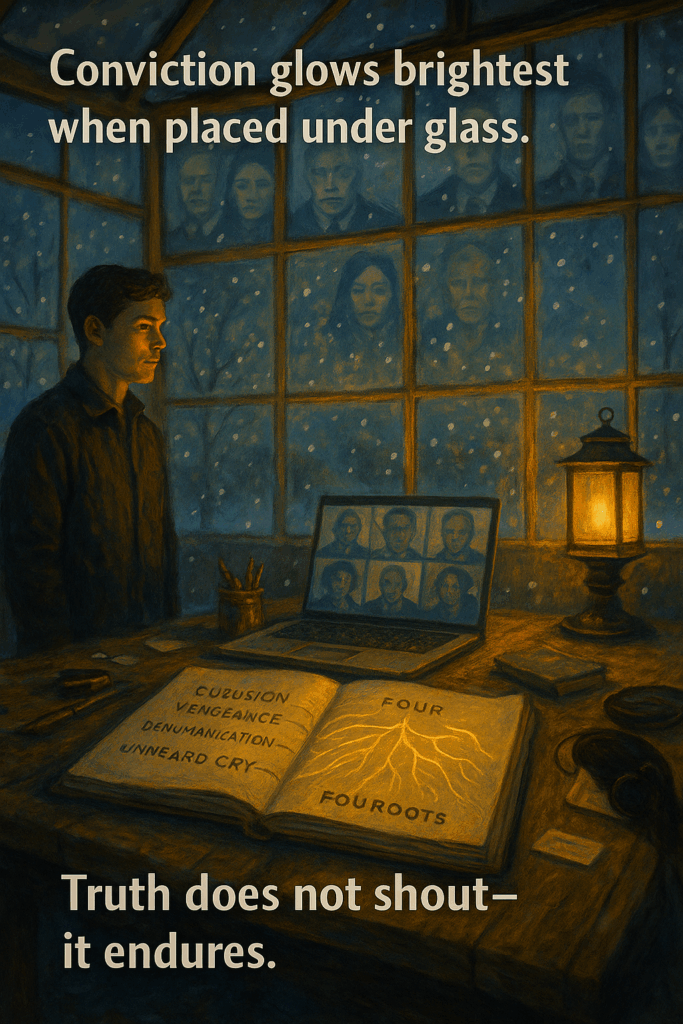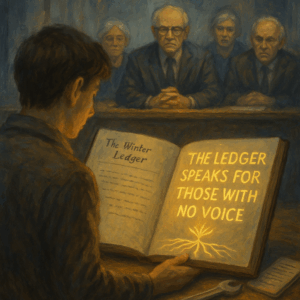
The greenhouse heaters hummed against the February frost, their soft vibrations echoing beneath the glass. Emil stood at the scarred table, watching condensation drip down the pane like hesitant thoughts. The ledger lay open to the last entry—The Gardener’s Faith—its ink now dry but the words still warm in memory.
Few weeks had passed since the Circle had submitted their feasibility report, and the council’s silence had turned from pause to pressure. Until that morning.
Priya’s headset crackled as the council’s emblem appeared on the laptop screen—a golden seal dissolving into a grid of faces. Hargrove’s square dominated the top row, his expression unreadable behind rimless glasses. A few analysts sat beside him, scrolling through the report. A thin line of skepticism framed every gesture.
Emil glanced toward his team. Aisha stood by the mural board, sleeves streaked in faded reds and golds; Jaden hunched beside a metal model of the canopy, tapping a wrench nervously; Mina held the quiet-box archive; and Olena sat upright, a translation notebook open, her fingers tracing Ukrainian script like a prayer.
“Begin,” said Hargrove, his tone clipped. “Your feasibility report proposes… qualitative peace indicators.” He adjusted his glasses. “Fifteen percent conflict reduction is measurable. Empathy resonance, however, is not. Can you define it in statistical terms?”
Priya inhaled sharply but held her composure. “Empathy resonance,” she replied, “is measured through sustained behavioral change—frequency of conflicts, tone of dialogue, engagement in shared projects—”
Another council member interrupted. “That’s correlation, not causation.”
Aisha leaned forward. “And yet, sir, it’s correlation that saved East Riverton. You can’t measure sunlight by grams, but you can see what it grows.”
A silence followed—long, uncomfortable, almost reverent.
Emil stepped in, voice steady. “We aren’t replacing numbers; we’re restoring context. Data without story is like a root without soil. It dries out.”
Hargrove frowned, flipping through digital pages. “Your report references something called the Four Roots Table. Explain it.”
Emil nodded. “It’s the counterbalance to the Four Absences—our framework for healing. Where exclusion breeds division, we plant inclusion. Where vengeance breeds stagnation, we plant restoration. Where dehumanization kills empathy, we plant recognition. And where the unheard cry goes unanswered, we plant resonance—connection that sustains. The Four Roots turn data into living proof.”
Hargrove tapped his stylus. “And how do you quantify resonance?”
Olena spoke for the first time, her voice soft but certain. “When a child in Kyiv sends a quiet-box slip that says, ‘Someone heard me,’ that’s resonance. When a rival youth helps hang a mural instead of tearing it down, that’s resonance. We track participation and dialogue patterns—it’s traceable.”
The analyst to Hargrove’s left muttered, “Anecdotal.”
Olena met his gaze. “So was the first heartbeat before you had a stethoscope.”
A hush settled. Even Hargrove’s pen paused mid-click.
Priya pulled up a chart—four colored lines looping around a central seed icon. “Our model blends behavioral analytics with social indicators. Conflict reports, school attendance, community volunteer hours. These are measurable. Empathy isn’t abstract—it leaves patterns.”
Jaden added quietly, “And it builds metal that doesn’t rust—like this canopy. Steel framed by trust.”
Hargrove’s expression softened, almost imperceptibly. “You believe your work can function in a war zone?”
Emil didn’t hesitate. “We don’t function despite war—we function within it. Peace doesn’t wait for stability; it creates it.”
The council fell silent. The glow of the laptop reflected on the greenhouse glass, turning their distant faces into ghostly silhouettes among the leaves.
Finally, Hargrove spoke. “Very well. The council authorizes a limited deployment. Kyiv Phase One—‘Human Resilience Pilot.’ You’ll operate under conditional oversight. Results by June 2026.” He leaned closer to the screen. “If this fails, Mr. Emil, it ends with you.”
Emil nodded slowly. “Then if we fail, we’ll fail forward—but never in silence.”
The call ended with a soft click.
The greenhouse exhaled.
Mina clasped her hands together, eyes glistening. “He didn’t say no.”
Aisha smiled faintly. “He didn’t say yes either. He said maybe.”
Priya closed her laptop. “Maybe is all a seed needs.”
Olena reached out, tracing a small sun in the frost on the glass. “Kyiv will see this light,” she whispered.
Emil turned to the ledger. He opened a fresh page, the heater hum rising like a heartbeat beneath the silence. The ink flowed easily this time—no tremor in the line.
Ledger Entry — The Ledger Under Review
Date: February 15, 2026
Symptom: Council skepticism challenges qualitative peace metrics.
Disease — The Four Absences (Institutional):
-
Absence 1 (Exclusion): Youth-led empathy framework dismissed as unscientific.
-
Absence 2 (Vengeance): Bureaucratic tone weaponizes fear of failure.
-
Absence 3 (Dehumanization): Voices reduced to data points.
-
Absence 4 (Unheard Cry): Kyiv’s local context overshadowed by political optics.
Investigator’s Response:
Defended empathy metrics through Four Roots model; reframed qualitative outcomes as measurable resilience; secured conditional Kyiv pilot approval.
Outcome:
Kyiv deployment authorized (Phase One: Human Resilience Pilot); Circle regains faith; leadership strengthened through calm endurance.
Note:
The world may weigh forests by numbers, but roots still grow by unseen light.


